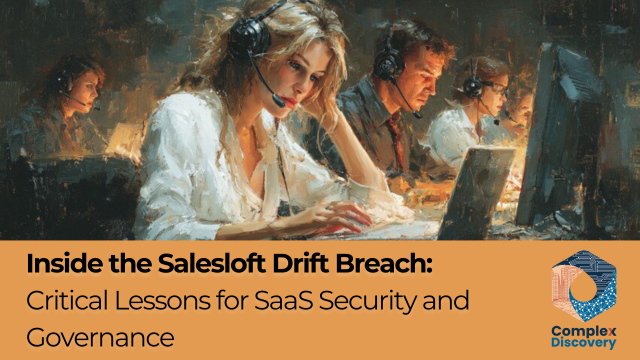
[EDRM Editor’s Note: This article was first published here on September 15, 2025, and EDRM is grateful to Rob Robinson, editor and managing director of Trusted Partner ComplexDiscovery, for permission to republish.]
ComplexDiscovery Editor’s Note: The Salesloft Drift breach, which affected over 700 organizations between August 8–18, 2025, marks a defining moment in the evolution of SaaS-related supply chain attacks. With attackers exploiting OAuth token vulnerabilities in a widely used third-party integration, this incident surfaces urgent lessons for cybersecurity, information governance, and eDiscovery professionals. From the failure of multi-factor authentication defenses to the complexity of cross-platform data governance, the breach reveals critical blind spots in today’s cloud-centric operational landscape. This article unpacks the key takeaways and outlines the strategic steps necessary to mitigate future risks in an increasingly interconnected digital ecosystem.
The Salesloft Drift breach that unfolded between August 8 and 18, 2025, represents one of the most significant supply chain attacks targeting Software-as-a-Service (SaaS) platforms in recent years. This sophisticated cyberattack, orchestrated by the threat group UNC6395 (also designated as GRUB1 by Cloudflare), has exposed fundamental vulnerabilities in third-party integration security and delivered critical lessons for cybersecurity, information governance, and eDiscovery professionals.
This sophisticated cyberattack, orchestrated by the threat group UNC6395 (also designated as GRUB1 by Cloudflare), has exposed fundamental vulnerabilities in third-party integration security and delivered critical lessons for cybersecurity, information governance, and eDiscovery professionals.
Rob Robinson, Editor and Managing Director, ComplexDiscovery.
The Anatomy of a Modern Supply Chain Attack
The breach began with a compromise of Salesloft’s GitHub account between March and June 2025, providing attackers with the initial foothold needed to conduct extensive reconnaissance. The threat actors systematically exploited OAuth tokens associated with the Drift chatbot integration, enabling unauthorized access to hundreds of Salesforce instances without triggering multi-factor authentication mechanisms.
Over 700 organizations were ultimately affected, including prominent cybersecurity firms such as Cloudflare, Palo Alto Networks, Zscaler, Google, Proofpoint, SpyCloud, Tanium, and Tenable. The attackers demonstrated operational sophistication by using automated Python tools to extract large volumes of data while employing anti-forensics techniques to delete query logs and evade detection.
Critical Implications for Cybersecurity Professionals
This incident underscores the urgent need for enhanced OAuth token management and third-party integration oversight. Traditional security perimeters have shifted from individual enterprise boundaries to the broader ecosystem of SaaS integrations, creating new attack surfaces that require dedicated attention.
OAuth Token Vulnerabilities: The breach highlighted that OAuth tokens, by design, can bypass multi-factor authentication, making them high-value targets for cybercriminals. Organizations must implement stricter token lifecycle management, including regular rotation, scoped permissions, and real-time monitoring of OAuth activity. The incident highlights the need to treat these digital credentials with the same level of security rigor as traditional passwords and access keys.
Supply Chain Risk Assessment: The widespread impact across multiple industries emphasizes the need for comprehensive third-party risk management programs. Organizations must expand their security assessments beyond direct vendors to include fourth and fifth-party risks inherent in interconnected SaaS ecosystems. Regular auditing of third-party integrations, coupled with zero-trust access controls, has become essential for maintaining an organizational security posture.
Information Governance Challenges and Responses
The Salesloft Drift breach exposes significant gaps in information governance frameworks, particularly regarding data handling in multi-tenant SaaS environments. The incident affected customer relationship management data, support case information, and potentially sensitive credentials shared through various business communications.
Data Classification and Protection: Organizations must implement comprehensive data classification schemes that account for information shared through third-party platforms and other external sources. The breach revealed that seemingly routine customer support interactions can contain sensitive information, including API keys, passwords, and other credentials that require enhanced protection. Information governance professionals should establish clear guidelines for what data can be shared through external platforms and implement technical controls to prevent inadvertent exposure.
Cross-Platform Visibility: The incident demonstrated the challenges of maintaining data visibility across interconnected SaaS platforms. Organizations need to develop governance frameworks that provide comprehensive oversight of data flows through third-party integrations, ensuring that sensitive information remains protected regardless of the platform hosting it.
eDiscovery Implications and Preparedness
The Salesloft Drift breach carries profound implications for eDiscovery professionals, highlighting the complexity of data preservation and collection in modern cloud-based business environments.
Breach Response and Legal Hold: The incident has already triggered multiple class-action lawsuits against affected organizations, including Salesforce. eDiscovery professionals must be prepared to handle breach-related litigation that spans multiple platforms and jurisdictions. The interconnected nature of modern SaaS platforms means that a single breach can trigger preservation obligations across numerous systems and vendors.
eDiscovery professionals must be prepared to handle breach-related litigation that spans multiple platforms and jurisdictions. The interconnected nature of modern SaaS platforms means that a single breach can trigger preservation obligations across numerous systems and vendors.
Rob Robinson, Editor and Managing Director, ComplexDiscovery.
Cloud-Based Evidence Collection: The breach underscores the importance of understanding data residency and access controls in cloud environments. eDiscovery professionals must develop expertise in collecting evidence from compromised SaaS platforms while ensuring the integrity of potentially tainted data. Organizations should establish incident response protocols that account for the unique challenges of preserving electronic evidence in multi-tenant cloud environments.
Regulatory Compliance: The incident has implications for various data protection regulations, including GDPR, CCPA, and industry-specific requirements. Organizations affected by the breach must navigate complex notification requirements while managing potential regulatory investigations and inquiries. eDiscovery professionals should prepare for requests that span multiple regulatory frameworks and jurisdictions, requiring a sophisticated understanding of cross-border data protection laws.
Lessons Learned and Strategic Recommendations
The Salesloft Drift incident provides several critical lessons for professionals across cybersecurity, information governance, and eDiscovery domains:
Integration Security as a Board-Level Priority: Organizations must elevate third-party integration security to board-level oversight, ensuring that OAuth governance and vendor risk management receive appropriate executive attention and resources.
Proactive Monitoring and Detection: The breach remained undetected for over two weeks, emphasizing the need for enhanced monitoring capabilities that can identify anomalous OAuth token usage and suspicious API activity across integrated platforms.
Incident Response Coordination: Effective breach response requires coordinated action across multiple vendors and platforms. Organizations should establish clear communication protocols and shared responsibility models for managing incidents that span multiple SaaS providers.
Legal and Compliance Preparedness: The growing trend of supply chain attacks targeting SaaS platforms requires enhanced legal preparedness, including pre-negotiated breach notification procedures and clearly defined liability frameworks in vendor contracts.
The Salesloft Drift breach marks a watershed moment in understanding the evolving threat landscape in cloud-centric business environments. As organizations increasingly rely on interconnected SaaS platforms, the traditional boundaries between internal and external security controls continue to blur. Success in this new environment requires collaborative expertise across cybersecurity, information governance, and eDiscovery disciplines, supported by comprehensive risk management frameworks that account for the realities of modern digital business operations.
Success in this new environment requires collaborative expertise across cybersecurity, information governance, and eDiscovery disciplines, supported by comprehensive risk management frameworks that account for the realities of modern digital business operations.
Rob Robinson, Editor and Managing Director, ComplexDiscovery.
For professionals in these fields, the incident highlights the critical importance of staying ahead of emerging threats while building resilient operational frameworks that can respond effectively when prevention efforts fall short. The lessons from this breach will likely influence security practices, governance frameworks, and legal strategies for years to come.
Read the original article here.
About ComplexDiscovery OÜ
ComplexDiscovery OÜ is a highly recognized digital publication providing insights into cybersecurity, information governance, and eDiscovery. Based in Estonia, ComplexDiscovery OÜ delivers nuanced analyses of global trends, technology advancements, and the legal technology sector, connecting intricate issues with the broader narrative of international business and current events. Learn more at ComplexDiscovery.com.
News Sources
- Widespread Data Theft Targets Salesforce Instances via Salesloft Drift (Google Cloud Threat Intelligence)
- Cloudflare and Palo Alto Networks Victimized in Salesloft Drift Breach (Infosecurity Magazine)
- Salesloft Drift security incident started with undetected GitHub access (CyberScoop)
- More Cybersecurity Firms Hit by Salesforce-Salesloft Drift Breach (Security Week)
- The Ongoing Fallout from a Breach at AI Chatbot Maker Salesloft (Krebs on Security)
- Salesloft Takes Drift Offline After OAuth Token Theft Hits Hundreds (The Hacker News)
- Palo Alto Networks, Zscaler customers impacted by supply chain attacks (Cybersecurity Dive)
Additional Reading
- Phantom Hacker Fraud: The Corporate Risk You’re Not Monitoring
- When Legal Privilege Isn’t Enough: Cyber Threats Escalate in the Legal Industry
Source: ComplexDiscovery OÜ
Assisted by GAI and LLM Technologies per EDRM GAI and LLM Policy.

